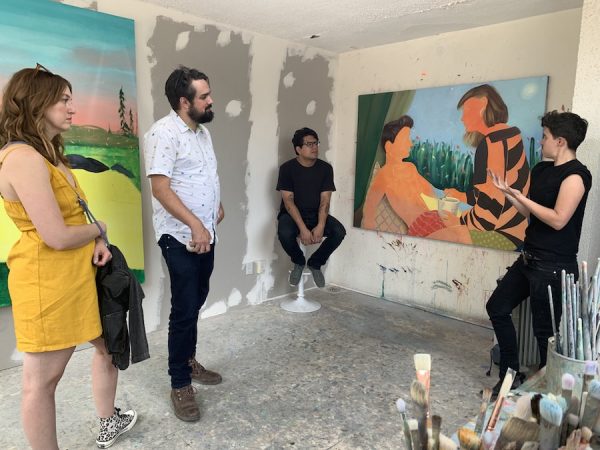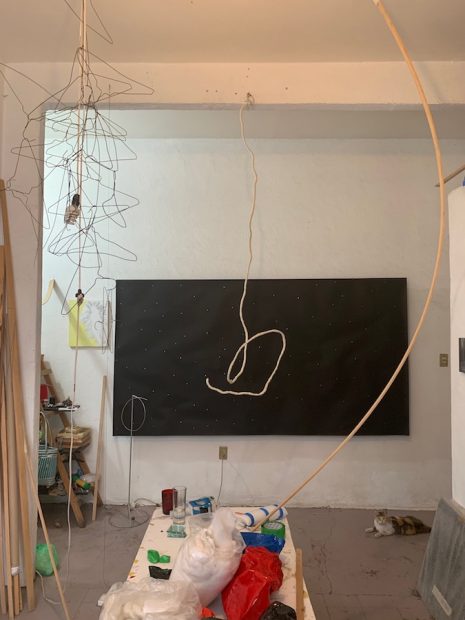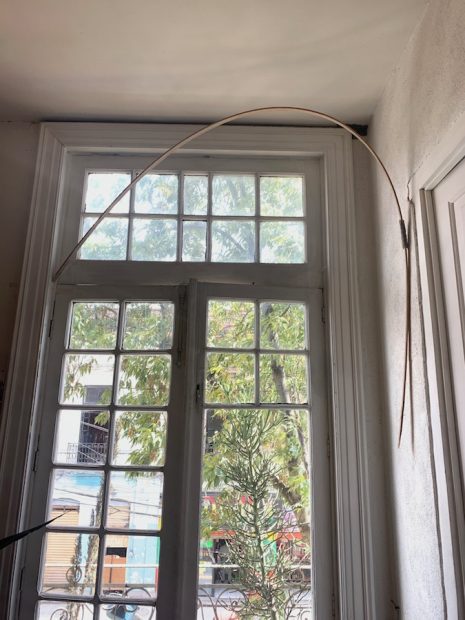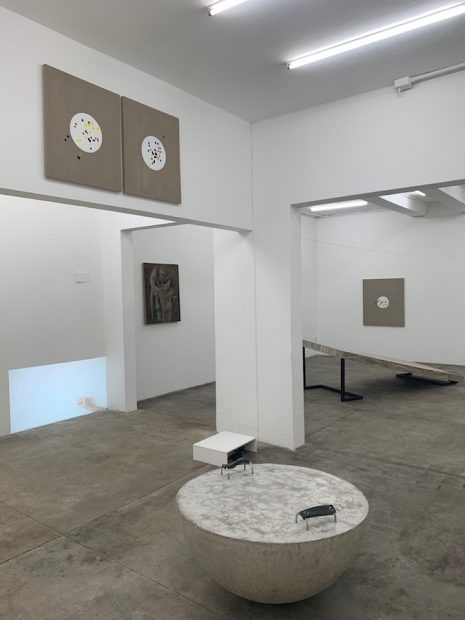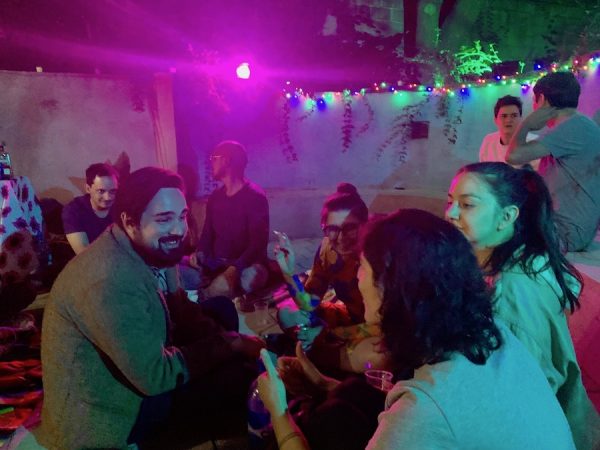The following is Part Three in a series of three art-travel essays by the author. Find Part One (Guadalajara) here, and Part Two (Monterrey) here.
Para leer este artículo en español, por favor vaya aquí. To read this article in Spanish, please go here.
We landed in Mexico City later than we expected. Two of the three of us were home and eager to get into our own beds. We were parting ways that night for the first time in a full week. Traveling is always easy alone, when you can set your own time limits, plan visits and meetings to suit your own schedule, and hibernate on the nights you need to. Traveling for the first time with friends can sometimes feel like rolling a square wheel, until a groove sets in and you’ve all found your roles and begin to read each other’s minds.
Once we landed, we hopped into our separate Ubers and set off in our different directions, with a plan to meet at my house in the morning before our first artist visit. Mexico City is structured very differently from Guadalajara and Monterrey. Here, we would visit residencies, the SOMA school, and artists we had wanted face time with for some time. Mexico City was more about catching up, and ending with a reunion party for everyone who’d supported our trip with recommendations and introductions, as well as our artists alumni that had participated in Unlisted Projects, an artist residency program that I cofounded. It was good to be home, and I knew the days of reconnecting would be long ones. That first night back home was a quiet one.
* * * *
Our next morning began slowly. Around noon we all piled in a car for the half-hour drive to visit with painter Ana Segovia.
We were in Mexico City at the height of the dry season. Our route took us to the second level of the Periferico highway, one that was once a loop in the outskirts of the city but now moves urban dwellers through the city quickly. The contamination in the air was visible. We could taste it and feel the heavy particles of dust in our noses as we inhaled. The views of the city from the highway were clouded with a brown haze.
Ana Segovia (pictured at top) is scheduled to come to Austin in July of this year. I had been following her work for two years — the same amount of time she had been back in Mexico City after finishing her BFA at the Art institute of Chicago. Ana told us the story of her family lineage, which is deeply immersed in the golden era of Mexican cinema, where many of the tropes, stereotypes, and codes of masculinity and machismo were perpetuated and became intricately woven into the identity of “Mexicanness.” Ana’s work is in direct response to these tropes — either subverting them, challenging, or changing them altogether. It is the strength, content, and context of her work that initiated an invitation to Unlisted Projects Residency in Austin, but it was also her character as a creative being that solidified that invitation.
One of the most under-appreciated factors of running a residency program is understanding personalities. Inviting any artist is a small leap of faith, the assumption that everything will work out fine. Essentially, you’re inviting near strangers to come live in your home and become part of the surrounding art community. This leaves the door open as much for success as it does for mistakes. We’ve been lucky thus far; we’ve found personalities who are successful in our space. We’re also lucky to have such a supportive and vibrant community of Austin artists who welcome our visiting artists in every way.
Our conversation moved from Ana’s physical work to logistics and ideas of connectivity for her residency. After that visit, we hopped in a car and settled in for another long ride to the Santa Maria la Ribera neighborhood, just outside of downtown, to visit Manuela Garcia.
It’s hard to write about Mexico City without describing the massiveness of it. We’d spend an equal amount of time traveling by car from place to place as we would visiting artists. The city’s expansiveness is impressive; a whopping 20 million people live on top of each other, fighting for space and air. When we arrived at Manuela’s doorstep, getting out of the car felt like we were slowly unfolding ourselves. Between the traffic and the distance, we welcomed a moment to stand.
We walked up the stairs to Manuela’s studio — a beautiful, light-filled space of three tiny rooms joined together by a narrow hallway. We became very aware of our size as we followed Manuela through her space, through which she moved with grace and ease, all the while dodging works in varied stages of progress coming out of the walls, sitting on shelves, or rolled in corners. Each small experiment was a bold, tiny, and poetic gesture that forced us to take a moment to analyze how each work behaved. In the middle of the main space, a long and narrow piece of wood, resting on a table top, held tension as it extended to the ceiling above, curving beautifully in its center. Manuela tapped the piece, sending it spinning around its own axis and yet remarkably holding its tension. We all gasped in surprise. She is fearless, and it was wonderful.
We could have spent much more time studying the way Manuela worked and spoke about objects in the world, but once again our time was winding down. We walked out of her studio single file and said our goodbyes on the street.
Our next destination was the Mexico City hub of the Casa Wabi Residency, based in Puerto Escondido, Oaxaca. We were scheduled to meet with curator Paola Jasso to talk about the residency’s programs. It was the final official visit of the day before ending with a late lunch at an infamous cantina in the neighborhood. We took in the sights as we strolled through the main square on our way to Casa Wabi. Somehow the pace of our trip had suddenly slowed down, ironically so, since we were in the cosmopolitan mega-center of the city. But here, time is different. It’s almost as if the city places as many obstacles in your path as it can, and arriving anywhere is like a small victory. Arriving on time is like winning a marathon.
We strolled into the Casa Wabi gallery space and were led upstairs to a comfortable conference room. The gallery was one small room of a large, impeccably designed home converted to offices and work spaces. On our way up we were caught off guard by room after beautiful room. Paola joined us in the conference room and we all made ourselves comfortable as we began to chat. Casa Wabi, a non-profit, is the brainchild of artist Bosco Sodi, who built an enclave on a private section of beach in Puerto Escondido, Oaxaca. Young artists from all over the country are invited to the residency to live and work for four to six weeks, and one requirement is that they connect with the immediate surrounding community — a connection that culminates in a public program or project of some sort. The brick-and-mortar gallery in Mexico City functions as an exhibition opportunity for young artists who do not have gallery representation.
Paola is an incredibly busy woman, but doesn’t show it. Her cell phone buzzed incessantly. She turned it off. She has a general calm about her, and that mixed with the gorgeous design of the space makes the experience of sitting with her an easy one. And while we could have wandered around that house for another two hours, we were getting hungry.
Our lunch destination had been decided by Ana Segovia, who planned to meet us there. It was in the neighborhood. Cantina lunches are always a cultural experience, but this cantina, Timón de Cortes, is unique because no matter the time of day, or day of the week, someone at Timón de Cortes occupies the microphone and owns the stage. It’s a cantina and a traditional karaoke bar; amateur performers are compelled to showcase their talent through famous ballads and Mexican pop music from the late ’90s. It was three in the afternoon when we sat down, ordered a round of beers and tacos, and the woman at the mic had already been singing her heart out long before we arrived. Ana joined us, and we all watched as the microphone was passed between three different people who were clearly living out their dreams of pop stardom. We were happy to oblige them as their audience.
* * * *
I woke up the next morning with a swollen throat and a mild fever. I blamed the altitude and pollution. We had an early visit with Armando Rosales. I got myself together and out the door. We were meeting Armando at the Espacio de Arte Contemporáneo (ESPAC), a collecting foundation that invites young artists to work with the collection and produce exhibitions in its space. We were lucky enough to be in the city to catch Distancia Doble (Double Distance), a collaboration between Armando and Ana Bidart, whom we would meet later that afternoon. Armando gave us a walk through of the show, and a digital studio visit to show us his work trajectory and his development as an artist. His work takes quotidian objects or social norms and subverts them. It’s a gesture as simple as learning to write with the left hand by repetitively writing phrases from historical textbooks — phrases which just happen to be socialist-leaning. Or using a standard shipping crate leftover from an art fair as a roving exhibition space. As we stood there listening to him, I felt myself declining.
I quietly dipped out of our meeting and promised to meet up with the group again that afternoon for the rest of our studio visits. I hopped in a car and went straight to the doctor, who confirmed a severe respiratory infection and then sent me off with a cocktail of antibiotics (including a daily injection in the bum for six days) and a prescription for rest.
I woke up hours later even more exhausted, but determined to not miss the afternoon visits. Talking with artists in their spaces is my favorite part of the job, and I felt the responsibility to be present in the visits we had planned that afternoon. I sucked it up and made my way to meet everyone at the apartment studio of Javier Barrios, a young artist originally from Guadalajara who had been in Mexico City for a number of years.
For much of his art career Javier had dealt with political issues, until his curiosity turned to decorative imagery — namely flowers. He talked us through the migration patterns and subtle political implications of wealth and class in the existence and proliferation of orchids. Through drawings and delicately fabricated sculptures, Javier makes political gestures through highly aestheticized objects — beautiful things with subversive political content.
We had three more visits that day and our next stop was to Ana Bidart’s studio. Ana’s work is steadily gaining respect in the city’s art community. As we walked into her apartment she handed me a warm cup of tea and sat us all on the couch. She began to tell us about the importance of the line in her practice — it is the foundation of all her work and a point of departure for the quiet gestures she makes. Her work is not medium-specific, necessarily, but dependent on the time spent churning an idea in her head. Ana takes the necessary “thinking” time she needs to fully develop a project. At times that’s only a few weeks or months, and other times an idea develops over years.
There’s a direct link between all the artists we met that day. Each one of them had overlapped in some way at SOMA, an unaccredited education program that has filled a niche and need for MFA programs in the city. Over the course of our week of travel we had learned that a lack of arts education programs is a common problem throughout the country. Mexico City is no exception. That afternoon we sat down with SOMA’s new director Laura Cortés Hesselbach, who talked to us about SOMA’s educational programs, as well as the reason SOMA remains unaccredited. The criteria of Mexico’s public education system is restrictive and antiquated, and excludes many of the canonical artists that have shaped Mexico City’s art scene. By tapping the established community of artists and their expertise, SOMA has been able to maintain autonomy from the state while building an internationally respected academic program. Once again, we were seeing a system of mentorship, like we had seen in Guadalajara, but here it’s formalized in an ‘informal’ educational setting.
It was well into the evening when we said our goodbyes to Laura at SOMA. Our original plan had been to stick around for the evening Miercoles de SOMA (SOMA Wednesday) gathering and lecture, a weekly event that brings the art scene together. But I was fading, and went home to bed.
* * * *
We were in the home stretch of our trip; on the final day and we had planned a visit to the Casa Lu residency, followed by a reunion party for our Unlisted Projects alumni and close friends. Casa Lu is run by the fantastic Lupe Quesada, a ceramicist and connector whom I’d met through Sarah Fox in San Antonio, who was a resident nearly a year ago. Casa Lu is spread between two very different homes — one in the residential suburb of Tlalpan, and the second in the city itself. Both homes are stunning, comfortable, and hubs for creativity. Our visit to the home in the city took place between regular residency cycles, and Elisa Pinto had both the home and studio to herself to produce a body of work followed by a solo exhibition. Elisa was revisiting the collected memories of her father, who died when she was young. She was recreating the conceptual idea of a home with these memories, giving them physical place and space.
Lupe walked us through the house, told us about past artists and connections, and revealed that at one point her professional dream was to be a camp counselor — running the residency allows her to meet that impulse. Since we met a year ago, Lupe and I have become fast friends, and she’s been generous enough to share the public spaces of the Casa Lu homes for collective gatherings,such as long afternoon lunches and our much-anticipated party.
That night we all gathered in the yard of the house. We had the equivalent of a keg of beer in a giant metal basin full of ice, and a bottle of tequila. Paty Siller and Luis Nava of Janet40 — friends and our most recent resident artists — had taken care of everything, and their energy was effervescent. They had outfitted the place with Christmas lights, candles, and music. We spread pillows and blankets on the ground, and all our favorite people started trickling in. We were surrounded by nearly all of our alumni residents, and the friends who had taken care of us through our entire trip from Guadalajara to Monterrey, and then Mexico City.
It felt like home, and we all felt at home together.
Special thanks to: Lupe Quesada, Joaquin Segura, Virginia Colwell, Yeni Mao, Tanya Diaz, Brittany Baranowski, Rebecca Marino, Wimpy Salazar, Daniela Libertad, Andrea Martinez, Alejandro Garcia Contreras, Ignacio Neri, Ruben Gutierrez and every single person who shared a beer with us.
For more information on Unlisted projects, please visit https://www.unlistedprojects.com/


